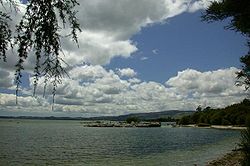“This report shows that even in one of the poorest and most disadvantaged regions of the state and nation, California’s existing climate policies can provide net economic benefits,” said Ethan Elkind, who coordinated the report for the Center for Law, Energy and the Environment (CLEE) at the UC Berkeley School of Law. Researchers looked at three key California climate and clean energy policies: 1) cap-and-trade, which established a market designed to reduce carbon emissions from major polluters; 2) the Renewables Portfolio Standard (RPS), which calls for California to get 33 percent of its energy from renewable sources by 2020, growing to 50 percent by 2030; and 3) energy efficiency programs run by investor-owned utilities and overseen by the Public Utilities Commission....
Cap-and-Trade
After accounting for compliance and other costs, the UC researchers estimate the cap-and-trade program had a direct economic benefit of $119 million to the San Joaquin Valley, and boosted the economy by $200 million when you include indirect and induced economic benefits. If you include spending that has been allocated but not yet disbursed, those numbers rise to $1 billion in direct economic benefits and $1.5 billion when including indirect economic benefits.
Proceeds from carbon auctions disbursed in the region so far have largely gone towards initial work on the state’s high-speed rail project, affordable housing, irrigation modernization and electric vehicle incentives. The study found that industries benefiting from the investment of cap-and-trade revenue, such as construction, generate more economic activity in the region than those industries bearing the costs of cap-and-trade compliance.
Researchers calculated a potential negative impact on 400 jobs due to compliance, but found that on a net basis, more than 700 jobs were created directly, and more than 1,600 supporting service and industry jobs were created indirectly, from 2013 through 2015. In the same period, state and local tax revenues received a $4.7 million boost.
Renewables Portfolio Standard
A lot of attention is paid to the state’s carbon cap-and-trade program, but in terms of the San Joaquin Valley’s economy, the state’s Renewables Portfolio Standard (RPS) has had a bigger impact so far. Construction on renewable energy projects has resulted in $11.6 billion in total economic activity in the Valley.
The San Joaquin Valley is home to 24 percent of the state’s solar generation and 54 percent of the state’s wind generation, providing significant employment opportunities in the region.
“Building and operating renewable energy facilities means jobs,” Jones said. From 2002 to 2015, renewable programs created about 31,000 direct jobs in the San Joaquin Valley – for people building and operating renewable energy facilities, for example – and created another 57,000 indirect and induced jobs for suppliers, supporting businesses and the like, for a total of 88,000 jobs. “Most of these direct jobs are the well-paid, local, career-track jobs the Valley really needs,” concluded Jones.
Energy Efficiency Programs
The report found energy efficiency programs overseen by the California Public Utilities Commission (CPUC) are cost-efficient vehicles for families, businesses and institutions to save energy and money year after year. By cutting demand, efficiency efforts also reduce the need for costly new power-generating infrastructure.
Energy efficiency programs in the San Joaquin Valley are the most cost-effective in the state, according to the report authors’ analysis of data reported by the CPUC. The report’s researchers found these programs in the Valley have provided net economic benefits of $248 million since 2010.
“Energy efficiency programs are job creators,” Jones said. “From 2006 to 2015, utility energy efficiency programs created 6,700 direct jobs, two-thirds of them in the construction industry and 10,700 indirect and induced jobs in the Valley, for a total of 17,400 jobs.“

















